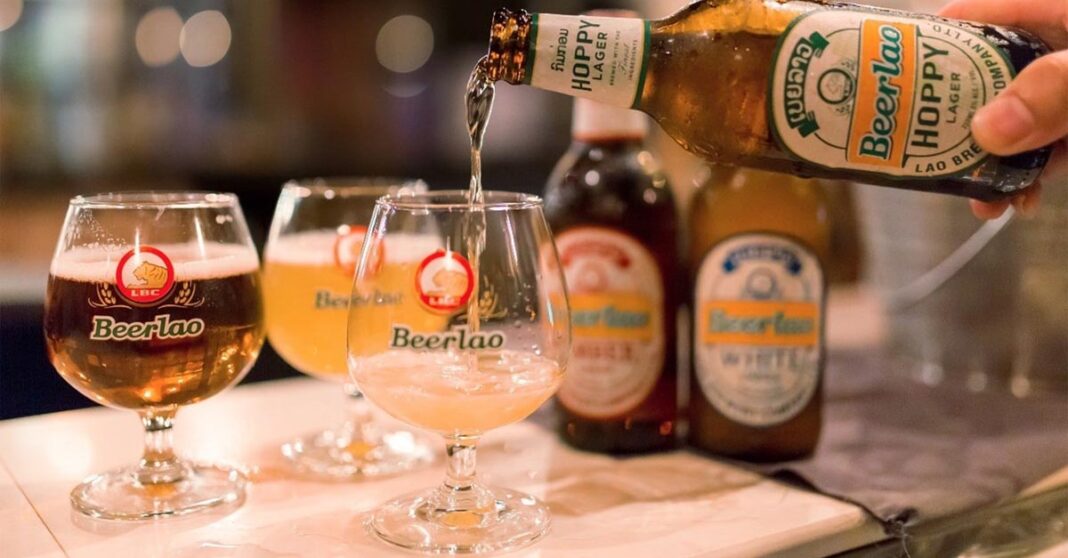In Laos, sharing drinks, especially alcoholic beverages, plays an important part in the culture as it helps encourage social connection and break the ice between strangers. The tradition not only serves as a means of hospitality but also helps people feel at ease in different social settings.
The country’s love for drinks rose to a new height and received global recognition for its high alcohol consumption. It reached a prominent position in the latest rankings by the World Population Review, an independent organization that focuses on providing current global population data and demographics.
Laos has now secured the first spot in Southeast Asia in “Female Alcohol Consumption,” with a per capita consumption rate of 5.09 liters per year. This places Laos ahead of its neighboring countries, Thailand and Cambodia, in the rankings as of 9 February.
The news has brought about the country a mix of surprise and a feeling of inevitability, considering the country’s drinking culture. However, Chantina Tinanoii, also known as “Tina,” a 29-year-old environmental and social specialist, expressed surprise at the ranking. “I’ve noticed that many young people in Vientiane Capital are trying to avoid alcohol, but this makes sense since we have more female populations than males,” she remarked.
Tina suggested that Lao people’s shy nature contributed to their drinking culture, explaining that the beverages help people become more outgoing and express themselves openly. “Laos people are shy and considerate, so when they drink, they can talk, open up, and share their opinions during that time in a small group,” she explained.
However, Tina emphasized that drinking alcohol is not the only means of enjoyment. She highlighted alternative activities such as games, dancing, singing, and engaging in meaningful discussions.
While acknowledging the persistence of some Lao individuals in encouraging others to drink, Tina believes they intend to ensure everyone’s happiness at social gatherings. “Lao people just want to ensure that all the people who attend their events or communities are happy,” she asserted.
For those who choose not to drink, Tina recommended providing a reason for their choice, whether due to health concerns or personal preferences.
Tina’s sentiment was supported by Siphachan “Max” Sawatvong, a Master IT student, who discusses alcohol’s impact on social interactions.
“I am not sure about drinking as a means to socialize, but from my observation, at a party, strangers tend to break the ice by offering drinks to one another,” he shared.
Despite his uncertainty, Max acknowledged the potential for drinks to strengthen bonds, “When we drink, it’s already a special occasion. It brings us close together,” he explained.
However, he highlighted a concerning aspect of the drinking culture across the Southeast Asia region: “I have seen some people forcing others to drink… They will be like ‘just a sip’ or ‘just a glass’ and might talk behind their backs if they do not drink.” In a community where alcohol plays a central role, those who abstain or decline may face social pressure and ostracization.
Nevertheless, Max distinguished himself by asserting that while he might encourage someone who has never drunk alcohol to give it a try he believed in respecting individuals’ choices and would never pressure anyone into drinking against their will.
Echoing Max’s sentiment, Douangsavanh “Jack” Phimmasone, a fourth-year Bachelor’s student at the National University of Laos, occasionally drinks for social purposes. He emphasized that non-drinkers may feel left out.
“You will be cheering with your juice or soda rather than beer, and it will be really awkward to be the only one there that doesn’t drink while others go all out,” he observed.
Jack also reinforced the role of alcohol in facilitating interactions and diffusing tension between individuals.
“Whenever you’re at a drinking event, they come to you, pour you some beer, and then they start to converse,” he remarked as he acknowledged the limitations of non-alcoholic alternatives in fostering the same level of social engagement.
“When you finish your beer, they’ll come right back to you, refill your glass, and begin another conversation with you, taking alcohol out of the equation. They cannot do the same with orange juice or Coca-Cola” he pointed out.
The widespread embrace of Lao drinking culture has not gone unnoticed by foreigners who have experienced life in Laos. Jason Rolan, an American residing in the country, confirmed Laos’s reputation for having some of the best beers in Southeast Asia.
“Beerlao and all of its different varieties are the best choices in Laos,” Rolan said.
In his observation, alcohol consumption has a big impact on social interactions and enjoyment, reflecting cultural norms worldwide.
“Traditional Lao gatherings often involve sharing meals and drinks, including beer or local rice whiskey,” Rolan added, stressing the essential role of alcohol in social customs.
However, he acknowledged a troubling trend: the increase in road accidents linked to drunk driving. He emphasized the importance of responsible drinking.
The Lao drinking culture blends with ancient social traditions, making alcohol both a connection and a barrier in social interactions. As Lao society, along with its Southeast Asian neighbors, navigates the complexities of alcohol consumption, their culture continues to evolve, showing layers of tradition, community, and personal agency with each shared drink.



